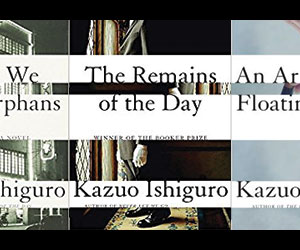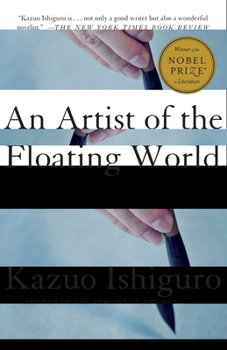An Artist of the Floating World
Select Format
Select Condition 
Book Overview
From the winner of the Nobel Prize in Literature and author of the Booker Prize-winning novel The Remains of the Day
In the face of the misery in his homeland, the artist Masuji Ono was unwilling to devote his art solely to the celebration of physical beauty. Instead, he put his work in the service of the imperialist movement that led Japan into World War II. Now, as the mature Ono struggles through the...
Format:Paperback
Language:English
ISBN:0679722661
ISBN13:9780679722663
Release Date:September 1989
Publisher:Vintage
Length:208 Pages
Weight:0.45 lbs.
Dimensions:0.6" x 5.2" x 8.0"
Related Subjects
Literary Fiction Cultural Identity Contemporary Fiction Genre Fiction Literature & FictionCustomer Reviews
5 ratings
The sometimes uncomfortable power of art
Published by Thriftbooks.com User , 19 years ago
What happens when legitimate art turns into propaganda and can propaganda be considered legitimate art? What happens to the artist who ventures into propaganda when his side loses the political battle? Can he still create art for art's sake?These are some of the questions explored in An Artist of the Floating World, Kazuo Ishiguro's excellent novel of postwar Japan and the musings/fate of a renowned artist who, having served the imperial cause during the war, is now very much suffering for it.Ishiguro writes with an excellent blend of economy and descriptive language that wastes no words or passages on tangents or irrelevance. He creates postwar Japan so vividly it is a true "you-are-there" read. Very rarely are authors capable of weaving such realism into a non-contemporary setting. It's also a very fast moving story, in spite of the fact that in terms of action there is very little. You come to know and understand the characters so completely that it simply adds to the effect of the realism.A classic work by a very talented writer.
A quiet novel about art and war and good intentions
Published by Thriftbooks.com User , 20 years ago
"An Artist of the Floating World" is a beautiful little novel, written in typical Ishiguro style, with the calm surface waters belaying the rapid current that flows beneath. It is an interesting style that attempts to ape classical Japanese literature, infusing it with Ishiguro's innate Brittishness, coming from being born of Japanese parents but raised in Britain.As with his other novels, and part of his style, a knowledge of historical events is taken for granted on the part of the reader. Allusions are made to once-famous or infamous events and people, and names are dropped with the understanding that everyone is intimately familiar with WWII and the cultures of Japan and England.The title is a bit misleading, as the "Floating World" is usually associated with the Edo period of Japan, and not with the Fascist era of Showa. Anyone expecting Geishas and Samurai will be disappointed.A very quick and quiet read, "An Artist of the Floating World" is something than can be read over a weekend with a cup of green tea. It contributes a viewpoint, and a necessary one, to WWII Japan and paints a human face onto a troubled period of history. Love and family and duty are on display here, along with good intentions leading down dark paths, and the righteousness of actions and re-actions.Like "Remains of the Day," "An Artist of the Floating World" is an intimate, beautiful character sketch. Very much worth the limited time needed to enjoy the book.
Fascinating Japanese Parallel to "The Remains of the Day"
Published by Thriftbooks.com User , 21 years ago
I read "An Artist of the Floating World" twice in one week, once in fascination and once more to explore the nuances and subtleties that characterize Kazuo Ishiguro's novels. This short work, Ishiguro's second novel, was short listed for the prestigious Booker Prize. Both a character study and an intriguing glimpse of pre-war Japan, in many ways it is a Japanese parallel to Ishiguro's highly successful third novel, "The Remains of the Day".Ishiguro enjoys slowly revealing his characters through their recollection of events long past. The memories are often fragmented, sometimes hazy, someimes simply untrustworthy. In "An Artist of the Floating World" the situation is further complicated by the tendency of its protagonist, Masuji Ono, to misinterpret his own memories."An Artist of the Floating World" is a portrait as Masuji Ono saw himself, and as he believed that others saw him. It is three years after Japan's defeat and Ono is preoccupied with the negotiations around his younger daughter's proposed marriage. Last year Noriko's marriage negotiations with another young man were unexpectedly treminated by the groom's family. Almost without self-awareness, Ono begins to question whether his artistic support of the imperialistic movement in the thirties and during the war now places his daughter's prospects in jeopardy.Although Ono sees himself as a modest man, he overstates the impact that his military and patriotic art had in conditioning the Japanese people for the impending imperialistic war effort. It is never quite clear just how popular and widespread his war posters actually were. In contrast, Ono seems incapable of recognizing the magnitude of his crime against his best student, Kuroda, whom he betrayed to the authorities. He rationalizes that Kuroda's years in prison now give him credibility in the new Japan and that he will fare well in the post-war period. He is even so naive as to believe that Kuroda might be persuaded to overlook the past and thus support, or at least not hinder, his daughter Noriko's ongoing marriage negotiations.I highly recommend "An Artist of the Floating World" for readers either new to Kazuo Ishiguro or already familiar with his other novels. It is an intricate work of beauty.
Delicate and Beautiful
Published by Thriftbooks.com User , 22 years ago
I've read all of Kazuo Ishiguro's books, and, while "The Remains of the Day" is my very favorite, this small book comes in a close second. It is delicate in its theme and narrative, yet its effects are quite lasting."An Artist of the Floating World" takes place in 1948 in a quiet town in Japan. The protagonist, Masuji Ono, once a moderately famous artist, enjoys spending his days mopping his tatami and working in his garden, although the highlight of his life are the visits from his grandson, Ichiro. As Ono enjoys his retirement from painting, he also takes the opportunity to look back on his life and reflect upon its meaning.Ono's memories of the past are many; he has had a long journey from young, bohemian art student to retired, successful artist. In the 1930s, Ono took great pleasure in visiting the "red light" districts of Japan, but after his marriage, he settled down and devoted himself to his family and his painting.Ono and his late wife had three children. Sadly, his only son died during the war. His loss still affects Ono greatly, as it always will. His elder daughter, Setsuko, the mother of Ichiro, is, from all appearances, happily married. His younger daughter, Neriko, has not been quite as successful where marriage is concerned. Her first marriage negotiations were broken off and she is now involved in a second attempt.In one of the most intriguing sections of this book, Ishiguro describes the marriage negotiations that used to be routine in Japan. These negotiations are called a "miai" and involve what resembles a British high tea. First, the parents must be matched, as the two families involved must be within the same social and economic class. Once it has been decided that the parents of both the prospective bride and the prospective groom are a "fit," the couple is allowed to meet for the very first time. Only after everyone has given their stamp of approval can the actual wedding finally take place. Unfortunately, Neriko's first marriage negotiation failed when she was considered to be of a lower social class than her prospective bridegroom. Ono, who has a darker past than one might initially assume, is worried that it may possibly come to light and harm Neriko's marriage negotiations, causing them to fail for a second time.Ono's musings take us back to World War II Japan, a time when all Japanese felt extremely patriotic and a time when any "wrong" action could cause one to be labelled a traitor. Ono, through his art, endeavored to help the cause of Japan in the war. Now, Ono, who lost his both his son and his wife in the war, feels he must reflect on his actions and decide what the consequences of them really were. Does he require forgiveness? If so, from whom? Is he being silly and pompous in believing that his art actually made a difference? Or is he thoughtful and reflective; a man who wants and needs to take responsibility for his actions? I really don't know and Ishiguro doesn't tell us, much to this
complexity unraveled with a gentle hand
Published by Thriftbooks.com User , 23 years ago
Ishiguro is a master of subtlety and subdued emotions. His leading characters seem to wear a Japanese Noh mask to conceal deep-rooted trauma. Such restrained emotions work especially well where the leading characters are Japanese since, of course, Japanese people are known for their restraint (in order to harmonize with others). Ishiguro uses this methodology to glorious effect with this novel's complex story of an artist who lives much of his adult life through a very turbulent era in Japan (1930-1950). In time, piece by piece, he reconciles the changes in society, lifestyle, his family and, lastly, himself.As an added benefit, Ishiguro does a brilliant job in capturing the mood, scenery, and feeling of post-war Japan. The carnage of the war transcended every aspect of the country and its people. But miraculously, Ishiguro paints this picture with an optimistic (yet not rose-colored) flair which gives the book an uplifting feel.I think An Artist of the Floating World will appeal especially to older readers. Surviving the war, the rath of youthful "know-it-all"s and criticism of one's peers is an inspiration.
An Artist of the Floating World Mentions in Our Blog

And The Nobel Prize for Literature Goes To . . .
Published by Ashly Moore Sheldon • October 05, 2023
Unlike many literary prizes, the Nobel Prize is based on a body's author of work as a whole, rather than an individual title. This year's Nobel Prize for Literature has been awarded to Norwegian playwright Jon Fosse. Read on to learn about his impact, as well as that of winners from the past seven years.

Kazuo Ishiguro Wins 2017 Nobel Prize in Literature
Published by Bianca Smith • October 18, 2017
Last week author, Kazuo Ishiguro received a call most only dream of - he won the 2017 Nobel Prize in Literature!





